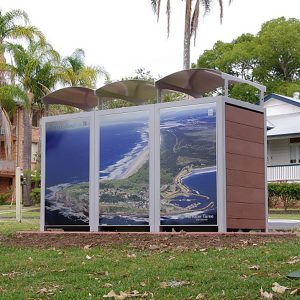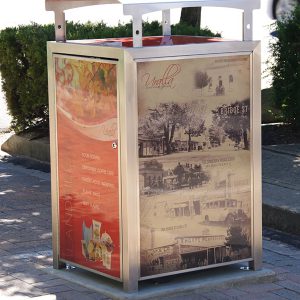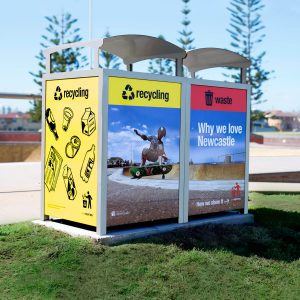
June 24, 2015
Why Can’t Bins Be Sexy?
Can Bins add to the beauty of their location?
Can they build on the stories which make a community unique?
Putting the design responsibility for public place bins into the hands of local communities and their representatives, is resulting in amazing collaborations. Public place bins are being created to not only complement the location, but also help to tell the story about what makes the community unique. From sourcing images through local community photo competitions, to the creation of historical photo collages of the area, Source Separation Systems is partnering with local councils with remarkable results.
 The National Park Range of public place bins was developed by Source Separation Systems in response to customer demand for customisation. The unique product allows customers to select from thousands of combinations of covers, apertures and side panels in a vast range of designs and materials. Whilst each bin shares the same durable steel frame to optimise manufacturing costs, the resulting bins are as unique as the communities creating the design.
The National Park Range of public place bins was developed by Source Separation Systems in response to customer demand for customisation. The unique product allows customers to select from thousands of combinations of covers, apertures and side panels in a vast range of designs and materials. Whilst each bin shares the same durable steel frame to optimise manufacturing costs, the resulting bins are as unique as the communities creating the design.
The National Park Bin side panels in particular provide an extensive range of options. Options include timber, 100% recycled composite panels, powder coated or stainless steel, commercial laminated panels, customised laser cut steel, changeable media panels, and even the transparent Security Bin panels. In addition, using cutting edge printing technology, the Hotham base features durable full colour graphics, protected with an anti-graffiti and anti-gouge coating, perfect for a truly unique solution.
REFLECTING A UNIQUE HISTORY AS A MEETING PLACE
Uralla, a name from the dialect of the Anaiwan people means ‘meeting place’. Located in NSW at the meeting of the New England Highway and Thunderbolts Way, the area celebrates a long history as a meeting place, a story which has been brought to life through the new street bins. In collaboration with the design leads at Source Separation Systems, the local community leads collated historical images of the locations into which the bins have been placed. These images were then overlayed onto historical street maps. The resulting bins really enhance the appearance of the street, and capture the essence of this historic location.
LOCALS SHARING THE BREATHTAKING BEAUTY OF THEIR COMMUNITY
The Manning Valley is also blessed with nine of the most unique and spectacular National Parks and nature reserves in NSW. It is these breathtaking locations which are now promoted along the public place bins in the areas which tourists frequent, along with QR codes which provide additional information about the local area and recycling practices. The Greater Taree Council collaborated directly with the community in the designs of their National Park Bins, running a local amateur photo competition to source some of the spectacular photos which have been used to create their stunning recycling stations.
 THE ESSENCE OF HISTORY AND CREATIVITY COMBINED
THE ESSENCE OF HISTORY AND CREATIVITY COMBINED
The Bellingen Shire is a unique area which brings together a strong history driven by its ecological diversity, and a creative modern culture. The council’s website invites visitors to ‘experience the vibrant spirit and soulful character …. nestled amongst some of the world’s most majestic and precious natural environment’. The National Park Bins, which have been designed by the local team, certainly reflect this unique combination of history and creativity.
The Dorrigo collages tell the amazing story of pioneers, such as those tree logging, who worked, perched high up in the wilderness, to build the community celebrated today.
All National Park Bins in this series have been designed to include recycling, and feature a curved top, differentiated apertures, and the unique Hotham graphic panels.
The Bellingen collages tell the story of technology and progress. Of communities gathering for bike races, and celebrating town marches. Of building the shops and roads needed for expanding communities and surviving floods. Of the industrial revolution as workplaces changed, and the horse and cart was slowly replaced with motor vehicles.
The Urunga collages are dominated by the riverbank, on which the community thrived. Recreational images of whole communities, from young kids to adult enjoying a refreshing swim. Transport images as bridges were built replacing ferries, sail power with engines. Images of the community growing, as hotels and café opened to cater for the visitors the river encouraged, and the town celebrated the opening of its Literary Institute in 1986.
ENGAGING THE LOCAL KIDS TO CARE FOR ‘THEIR’ ENVIRONMENT
Great Lakes had a different challenge with the local skate park, set amongst the pristine beaches and tourist areas, being the target of graffiti and an area of unsightly litter.
In a program to engage the local kids, the council organised a photo shoot with a professional photographer at the park, and the resulting photos were printed on the National Park Bins. The breathtaking aerial tricks performed by the local kids are now viewed with pride, and as a result the kids are managing the success of ‘their’ recycling bins.
PROMOTING AN IMPORTANT SUSTAINABILITY MESSAGE
At the location of some of Australia’s most beautiful coastline, Great Lakes Council designed a series of bins which were placed in popular tourist destinations to promoted the message of sustainability. The most powerful is an image of a young boy lifting up the ocean to reveal rubbish lying underneath, which asks “Where does your plastic go?”. The National Park Bins not only feature beautiful imagery complementing their location, but also help to encourage people not to litter.